
Adriaen van Ostade was a Dutch Golden Age painter of genre works.

Abraham van Calraet, or Kalraat was a Dutch Golden Age painter and engraver.
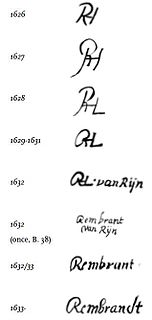
The Rembrandt Research Project (RRP) is an initiative of the Nederlandse Organisatie voor Wetenschappelijk Onderzoek (NWO), which is the Netherlands Organization for Scientific Research. Its purpose is to organize and categorize research on Rembrandt van Rijn, with the aim of discovering new facts about this Dutch Golden Age painter and his studio. The project was started in 1968, but has since become the authority on Rembrandt and has the final say in whether a painting is genuine.
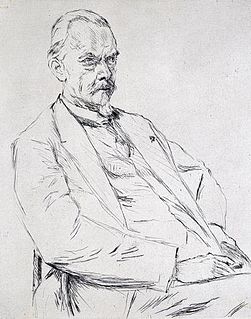
Cornelis Hofstede de Groot, was a Dutch art collector, art historian and museum curator.

Dr. Abraham Bredius was a Dutch art collector, art historian, and museum curator.

Horst Gerson was a German-Dutch art historian.

The Head of Christ is a 1648 painting by the Dutch artist Rembrandt. It is now in the Gemäldegalerie in Berlin.
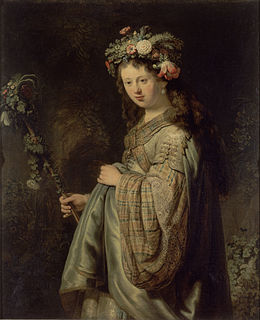
Flora or Saskia as Flora is a 1634 oil-on-canvas painting by Rembrandt, depicting his wife Saskia van Uylenburgh as the goddess Flora. It is held by the Hermitage Museum in St. Petersburg.

Portrait of Jan Six is a 1654 painting by the Dutch painter Rembrandt van Rijn. Having been handed down many generations, via the direct descendants of the portrait's subject, Jan Six, the work remains in the Six Collection in Amsterdam.
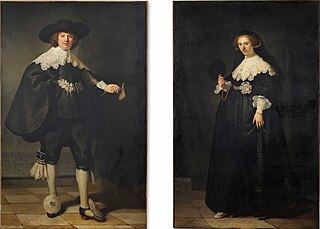
The pendant portraits of Marten Soolmans and Oopjen Coppit are a pair of full-length wedding portraits by Rembrandt. They were painted on the occasion of the marriage of Marten Soolmans and Oopjen Coppit in 1634. Formerly owned by the Rothschild family, they became joinedly owned by the Louvre Museum and the Rijksmuseum in 2015 after both museums managed to contribute half of the purchase price of €160 million, a record for works by Rembrandt.
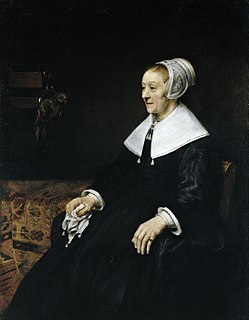
Portrait of Catharina Hooghsaet (1607–1685) is a 1657 painting by the Dutch Golden Age painter Rembrandt.

Portrait of Maria Trip (c.1639) is an oil on panel painting by the Dutch painter Rembrandt. It is an example of Dutch Golden Age painting and is now in the collection of the Rijksmuseum.
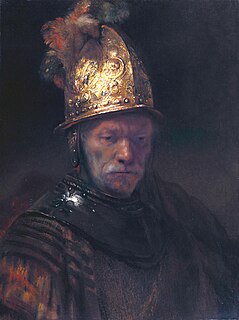
The Man with the Golden Helmet is an oil on canvas painting formerly attributed to the Dutch painter Rembrandt and today considered to be a work by someone in his circle.

View of Haarlem from the Northwest, with the Bleaching Fields in the Foreground is an oil on canvas painting by the Dutch landscape painter Jacob van Ruisdael. It is an example of Dutch Golden Age painting and is now in the collection of the Rijksmuseum.

Tobias and Sarah in Prayer with the Angel Raphael and the Demon is an oil on canvas painting by the Dutch Golden Age painter Jan Steen. It is now in the collection of the Bredius Museum, The Hague.

Head of Christ is a 1650s painting by Rembrandt's workshop. It shows Christ with a beard and long dark hair. It is in the collection of the Metropolitan Museum of Art.

The Shipbuilder and his Wife is a 1633 painting by Rembrandt. The sitters were identified in 1970 as Jan Rijcksen (1560/2–1637) and his wife Griet Jans Rijcksen. Rijcksen was a shareholder in the Dutch East India Company, and became its master shipbuilder in 1620. The painting has been in the Royal Collection since 1811.

Portrait of a Woman Wearing a Gold Chain is a 1634 portrait painted by Rembrandt. It shows a smiling woman with a triple lace collar. It is in the collection of the Museum of Fine Arts, Boston.

Portrait of a 62-year-old Woman, possibly Aeltje Pietersdr Uylenburgh is a 1632 portrait painting painted by Rembrandt. It shows an elderly woman with a small and sober millstone collar. It is in the collection of the Museum of Fine Arts, Boston.

Portrait of Petronella Buys (1610–1670) is a 1635 portrait painting painted by Rembrandt. It shows a young woman with a very large and impressive millstone collar. It is in a private collection.





















